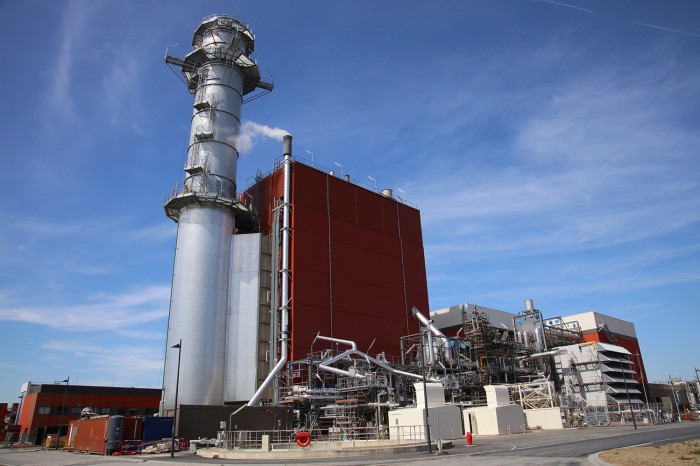The Internet of Things Could Keep Dirty Coal Plants in Business
Faced with excess electricity generation capacity and plunging prices for wholesale electricity, Italian utility A2A shut down its gas-fired Chivasso plant, near Turin, in 2014. Earlier this year, though, the plant was restarted. Market conditions have improved, but the main reason the plant was able to get up and running again was new cloud-based technology that helps it operate more efficiently, says Massimiliano Masi, A2A’s vice president of power generation and trading.
The GE hardware and software installed at the plant, Masi says, enables it to go from a dormant state to full operation in two hours or less, compared to three previously, thus improving its ability to respond to fluctuating demand brought on by increases in intermittent renewable energy on the grid. That’s a huge advantage, says Masi, “because transmission operators prefer plants that are able to reach full production in less time.”

GE released its digital power plant system for gas plants last fall and for coal plants in June. In new plants, GE’s technologies have increased the average efficiency (in terms of the available energy in the fuel that’s captured for electricity production) from 33 percent to 49 percent, the company says. For legacy coal plants, the efficiency improvements are more modest, while emissions of greenhouse gases can be reduced by 3 percent. Those gains come from optimizing fuel combustion, “tuning” the plant according to the properties of the coal being burned, and adjusting the oxygen flow in the boiler, and by reducing downtime due to equipment outages. GE is one of several big companies, including IBM, Siemens, and Schneider Electric, that now offer some form of digitization for big power plants, including both renewable and fossil fuel plants.
Utilities have been looking at harnessing the “Internet of things” for a decade, says Tim Riordan, vice president of engineering services for American Electric Power, but only recently has the technology advanced enough to justify the investment. “The potential is huge,” says Riordan, whose company is deploying both IBM’s Maximo asset management platform and Siemens’s Prism system to monitor its fossil fuel plant performance. But he cautions that “to truly integrate all of this, to take it to a grand scale, is not going to be an insignificant effort.”
As at Chivasso, such technology could help determine how long aging fossil fuel plants can operate. Decisions on whether and when to retire plants for good “go all the way to senior leadership,” says Michael Reid, the general manager of technical programs for fossil and hydro operations at Duke Energy. Duke has retired or converted to natural gas 16 coal plants since 2011 and plans to shut down nine more by 2020. Digital technology can improve the efficiency, flexibility, and emissions profile of aging plants, Reid adds, but “substantial design changes are required to make significant gains in these areas.”
Digitizing power plants can help integrate renewables onto the grid by making existing fossil fuel plants more flexible and better able to respond to fluctuations in the power supplied by intermittent sources like wind and solar. By helping the plants run cleaner and more efficiently, it can reduce emissions of greenhouse gases. But improving the performance of aging coal plants could have the opposite effect if utilities decide to keep them running rather than shutting them down. Indeed, one of the benefits GE touts is to “extend plant life with minimal capital investment.”
That would hardly be good for the planet. According to the Sierra Club’s Beyond Coal campaign, 236 coal plants, representing 104,672 megawatts of generation capacity, have retired or announced definite retirement dates in the last several years. Delaying those retirements would simply add more greenhouse gases to the atmosphere. An average 500-megawatt coal plant releases about 3.7 million tons of carbon dioxide into the atmosphere each year. Extending the plant’s life by five years would add 18.5 million tons to its lifetime emissions; reducing annual emissions by 3 percent, as the GE system promises to do, would reduce that total by half a million tons.
Such small gains, according to GE executives, are worth the expense and effort given the reality of continued fossil fuel use. According to the U.S. Energy Information Administration’s latest projections, fossil fuels will continue to make up more than three-quarters of total U.S. energy consumption until at least 2040. In energy-hungry developing countries that proportion could be even higher.
“In places like China and India, they’ve already locked in plans to build brand new coal power plants, and those plants are going to be on the grid for 30 to 40 years,” says Scott Bolick, head of software strategy and product management at GE. “We look at it as our responsibility to make sure those plants are as sustainable as they can possibly be.”
Keep Reading
Most Popular
Large language models can do jaw-dropping things. But nobody knows exactly why.
And that's a problem. Figuring it out is one of the biggest scientific puzzles of our time and a crucial step towards controlling more powerful future models.
The problem with plug-in hybrids? Their drivers.
Plug-in hybrids are often sold as a transition to EVs, but new data from Europe shows we’re still underestimating the emissions they produce.
Google DeepMind’s new generative model makes Super Mario–like games from scratch
Genie learns how to control games by watching hours and hours of video. It could help train next-gen robots too.
How scientists traced a mysterious covid case back to six toilets
When wastewater surveillance turns into a hunt for a single infected individual, the ethics get tricky.
Stay connected
Get the latest updates from
MIT Technology Review
Discover special offers, top stories, upcoming events, and more.